I couldn't find the specific amounts taken, aside from what was left behind. Could you please kindly provide details on how the exact amount taken was determined?
As I stated, he stole some ¥150,000. I believe he left ¥190,000 behind (which was located by the computer he used at 1:18am meaning it was unlikely he did not see it as it was right in front of him). He also left behind foreign currency, as well as jewelry and other valuables. I cannot provide details on how the stolen amount was determined, I assume it was done via checking Mikio's withdrawals, expenditure that day, what the family next door would have known. Also, Japan is a cash-based society, as I'm sure you know. All the more so 23 years ago. If you were to listen to FACELESS, you would know that Mikio was a meticulous man who kept strict financial records. The idea that someone, with no drugs or alcohol in their system, would destroy four human beings for such a low sum of money, while leaving a greater amount behind makes no sense to me. Nor do I believe it to be this killer's motivation.
I share the scepticism around these questions. Admittedly, these few items do present a bit of a paradox when considering the notion of deprivation. Regarding the clothing, it's important to note that the brand doesn't necessarily indicate wealth, especially in the case of Uniqlo, which is not particularly expensive. Additionally, we can't ascertain who purchased the clothes; perhaps they were acquired by his siblings or obtained at a discounted rate, - just a possibility.
The value of his M/X shirt, Uniqlo jacket (brand-new and just released a month before), Slazenger shoes, good knife, Drakkar Noir aftershave is running into the hundreds of dollars. That's without totting up the hat, the gloves, the scarf, and the bag. I am not suggesting the killer is wealthy. I am saying it's preposterous to suggest he's some kind of desperately poor homeless guy given all of the things that the killer leaves behind in the house.
As for the unusual choice of perfume, one could argue that it was selected to combat the lingering smell of fish, especially if the killer worked in a fish processing environment (restaurants, fish market, factory, etc). This might align with the idea of preparing for a date, investing in a fragrance to leave a lasting impression. However, the possibility also exists that the perfume was stolen or a Christmas gift.
He was not wearing the aftershave itself. They identified traces of it on his belongings showing past usage. Though I don't see what's so unusual about it? Again, zero pointing to a fish smell. Let alone going on a date?
Speculating about these peculiar yet not entirely implausible items on the same person, it's worth considering that the killer, who demonstrated exceptional skill in wielding the knife during the murders, may have been accustomed to working with such blades. The logical connection between the sashimi knife and the sand from Tuna Town strengthens this hypothesis.
What suggests to you that he had any skill wielding a knife? Maybe you might say the fact he wrapped in such a way to avoid cutting himself. Except then he did cut himself and lost a fairly significant amount of blood. He also broke the knife the second he used it and had to abort his subsequent attacks with it to trade up. It's quite possible he cut his other hand too. Respectfully, I see no logic in connecting a sashimi knife with one arbitrarily chosen port. Sashimi knives are quite obviously found all over Japan. What single shred of evidence points to Misaki Port?
I'm less inclined to explore the direction of a California desert or military background. A young army recruit would likely lack the expertise displayed in handling knives, especially sashimi knives. Moreover, combat knives, preferred in military settings, differ significantly from fish knives, and the techniques required to handle them vary. If someone were planning a murder, it seems more plausible that they would choose a combat knife over a fish knife due to its sturdiness. JMO.
I find it incomprehensible why anyone would reject the only single piece of evidence in these murders pointing to a specific location. Two types of sand: Mabori Beach and Edwards Air Base. And to do so on the premise that an army recruit would "likely lack" the expertise to knife handling. Well, as I've said, I see no expertise in these murders. Moreover, the theory is NOT that he's actually in the US Airforce. But the son of a man who is. The idea that he would chose the wrong knife only further solidifies the premise that he's not an expert of any kind.
The area appeared secluded, with houses that seemed affluent yet isolated. The entire neighbourhood exuded a sense of tranquillity, seemingly removed from the public eye. Adding to that, the bathroom window was conveniently situated on the opposite side, making it accessible for a nimble individual to climb up, remove the window frame and sneak in.
Have you been to the house? If so, you would know that it is not secluded. Not isolated. Yes, it was located in a small municipal park, where there were bushes and so on. But the killer ran a great risk of being spotted every second he lingered outside that house. What pictures do not show is the pretty constant foot traffic through that space. In the day, obviously, but so too after dark.

